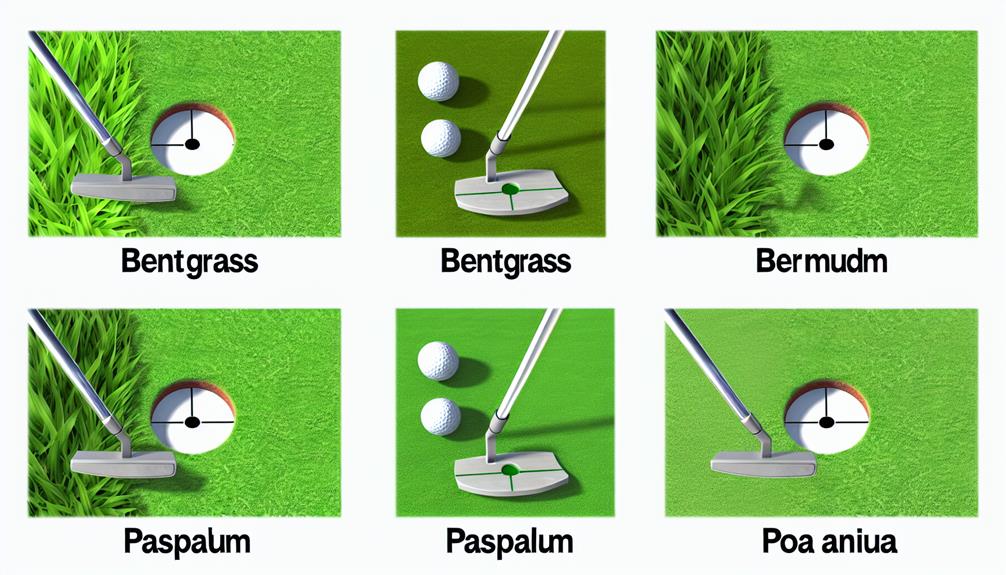Just as a painter chooses a particular brush to create the desired effect on a canvas, a golf course superintendent selects the ideal type of grass to create the perfect putting green.
You might not realize it, but the grass under your golf ball can significantly impact your game. There are several types of grasses, each with their own unique characteristics that determine how a golf ball will roll. Understanding these grass types, such as Bentgrass, Bermuda, Paspalum, Creeping Bluegrass, and Poa Annua, can give you an edge on the green.
But, how does each grass affect your game, and how can you use this knowledge to your advantage? Let's explore.
Bentgrass Putting Greens
You'll find that Bentgrass putting greens, known for their smooth texture and rich color, are a popular choice among golf course superintendents for their durability and playability. This grass type isn't only aesthetically pleasing, but also provides an excellent playing surface that can withstand heavy foot traffic and harsh weather conditions.
Bentgrass maintenance is a crucial aspect in preserving the quality of these greens. Regular mowing, fertilizing, and watering are required to keep the grass healthy and vibrant. Additionally, aerating the soil helps to ensure proper drainage and prevents the build-up of thatch.
Seasonal adaptability is another significant advantage of Bentgrass. It thrives in cool weather conditions, making it an ideal choice for golf courses located in temperate regions. However, it's important to note that during warmer months, extra care is needed to prevent diseases and pests that can damage the grass.
Bermuda Grass Green Types
Shifting focus to Bermuda Grass greens, these are another excellent option, particularly favored in warmer climates for their heat resistance and durability. The dense growth of this grass type offers a smooth, consistent surface for the golf ball to roll, enhancing your game's precision.
Bermuda grass maintenance is relatively straightforward. It requires regular mowing, watering, and fertilization to maintain its lush, green appearance. It's also important to aerate it periodically to prevent soil compaction, allowing the roots to breathe. Don't worry, though; it's a hardy grass, tolerating heavy traffic well, making it an ideal choice for frequently used courses.
The Bermuda grass advantages are numerous. It's not just its resilience to heat that sets it apart. This grass type also has high salinity tolerance, allowing it to thrive in coastal areas where other grass types might struggle. Plus, it recovers quickly from damage, whether from divots or disease, ensuring your course stays attractive and playable.
Paspalum Grass Greens
While Bermuda grass greens offer a multitude of advantages, Paspalum grass greens are also worth considering for their unique characteristics and benefits in certain golf course conditions. Paspalum, native to tropical and subtropical regions, showcases remarkable adaptability. It thrives in a variety of climates, from the hot and arid to the cool and damp, making it a versatile choice for golf courses worldwide.
The Paspalum maintenance is relatively easy due to its resistance to diseases and pests. It's also tolerant of lower mowing heights, which can yield a smoother and faster green for your players. This grass type, furthermore, can withstand high salt levels, making it an ideal choice for seaside courses where salt spray might damage other grass types.
Paspalum's adaptability also extends to its ability to grow in both full sun and partial shade. This means that even if your golf course has varied light conditions, Paspalum can still provide a consistently high-quality putting surface.
Creeping Bluegrass Putting Surfaces
Often overlooked, Creeping Bluegrass makes a surprisingly excellent choice for golf course putting surfaces, offering a blend of durability and aesthetic appeal. This grass species, with its dense, fine-textured surface, provides a smooth and consistent ball roll, much to the delight of golfers.
However, to maintain its optimum performance, understanding Bluegrass maintenance is crucial. You'll need to keep an eye on soil pH levels, mowing heights, and irrigation schedules. Regular mowing at a low height helps to maintain the desired playing surface, while adequate watering ensures the grass remains healthy and resilient.
Climate suitability is another significant factor to consider. Creeping Bluegrass thrives in cooler climates, making it an ideal choice for courses in northern regions or at higher elevations. It's cold-tolerant and can withstand frost and freezing temperatures better than many other grass types.
Despite its benefits, Creeping Bluegrass does have its challenges. It's susceptible to diseases, especially in hot, humid conditions. Therefore, disease prevention measures should be a part of your maintenance regimen.
All in all, with the right maintenance and climate, Creeping Bluegrass can offer a top-notch putting surface for your golf course.
Poa Annua Greens Characteristics
Moving on from the Creeping Bluegrass, let's explore the unique characteristics of Poa Annua greens, another popular choice for golf course putting surfaces. Known for its Poa Annua resistance, this green withstands heavy traffic and diverse weather conditions, making it a favorite amongst course managers.
Poa Annua, or Annual Bluegrass, is typically light green, dense, and has a somewhat spongy feel underfoot. You'll notice it has a bumpy texture, which can make putting a bit unpredictable. This is due to its tendency to grow in clumps and its rapid growth rate.
However, fear not, as effective Annual Bluegrass management techniques can mitigate these challenges. Frequent mowing, strategic watering, and diligent aeration can help maintain a smooth and consistent putting surface.
Despite its maintenance requirements, the resilience of Poa Annua makes it an appealing option for many golf courses. Its adaptability to various climates and resistance to disease and pests contribute to its popularity.

